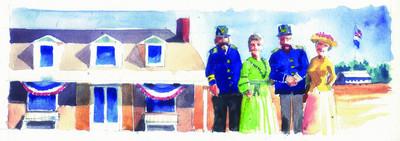Fort Verde preserves history for visitors to experience
A small gem among Arizona's state parks, Fort Verde preserves an important part of the history of the Old West. Located near the Verde River in scenic Central Arizona, this frontier outpost played an important role in the settling of Arizona during turbulent years in the late 1800s. Visitors today get glimpses of frontier life for soldiers, military families, Indian scouts and settlers.
To reach Fort Verde, head for Kingman, Ariz., using either U.S. 93 across Hoover Dam with its possible construction delays or U.S. 95 and Highway 163 to Laughlin, where Highway 68 takes you into Kingman. Get on Interstate 40 in Kingman, heading east to Highway 68, the route to Prescott. Fort Verde lies at the edge of the town of Camp Verde near I-17 about 40 miles east of Prescott, some 285 miles from Las Vegas.
Fort Verde State Historic Park remains open daily from 8 a.m. to 4:30 p.m., except Christmas Day. Rangers at park headquarters collect a $2 entrance fee for adults and $1 for youths. Children aged 6 and under enter free of charge. Facilities include a picnic area and restrooms. Acquaint yourself with the fort's history among the exhibits in the headquarters museum, then take the self-guided walking tour of restored buildings displaying period equipment, frontier relics and antique furnishings.
One of a string of forts established after the Civil War in 1865 when white settlers moved into territory historically occupied by Tonto Apache and Yavapai tribal groups, Fort Verde started as a tent camp manned by Arizona Volunteers. Regular troops relieved them in 1866. At first called Camp Lincoln, the post occupied low ground where malaria plagued the troops for several years. It acquired the name Camp Verde in 1868. In 1871, the army selected healthier, higher ground about a mile away where the present fort stands.
Visitors today see just a fraction of the fort on the grounds of the 11-acre park. Construction begun in 1871 finished in 1873 with 22 buildings ranged around an open parade ground. Four survivors preserved in the park include the fort's administration building and three houses from the officers' row.
The structures served the officers and men of a maximum of two cavalry and two infantry units, including the famous black recruits nicknamed the "Buffalo Soldiers." Renamed Fort Verde in 1879, the post's active life spanned about 20 years. The last of the military left in 1891. The government sold the post at auction in 1899. Many of the buildings then disappeared, torn down for the construction materials they contained.
During its brief life, Fort Verde witnessed a parade of frontier figures and events that changed the future of the region. Soldiers from Fort Verde constructed a key wagon road connecting Fort Whipple near the territorial capital at Prescott to the west with Fort Apache to the east, improving the movement of troops and equipment. The road became known as the Crook Road for General George Crook who led Indian fighting efforts aided by frontiersman and scout Kit Carson.
Fort Verde served as a staging area for military actions against hostile Indians. Soldiers based there struggled to implement the federal Indian policy mandating the reservation system as a means of controlling the native people of the West. Under famous head of scouts Al Sieber, the army used native scouts recruited from tribes in the area to hunt down renegades, often ranging out from Fort Verde. The last major battle of the northern Apache Wars occurred in 1882 just 37 miles east of Fort Verde at Big Dry Wash when 50 marauding renegades were killed or subdued and returned to their reservation.
The agricultural town of Camp Verde grew up near the fort which provided protection during perilous times. The town and the state park celebrate Fort Verde Days each October. On Saturday-Oct. 14, the town turns out for a parade and special events honoring the military at the fort. Living history presentations by costumed re-enactors, military drills and historical speakers help bring the past to life. For details of events, call the park at (928) 567-3275.
Margo Bartlett Pesek's column appears on Sundays.
MARGO BARTLETT PESEKMORE COLUMNS






















